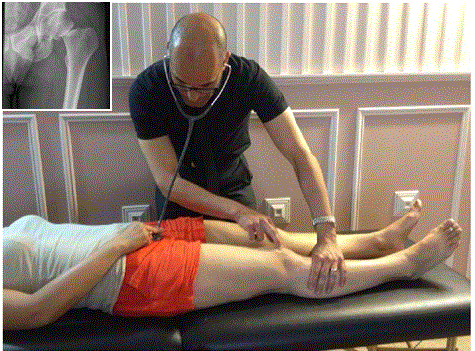Identifying a Hip Fracture that is missed on X-ray!
Reference:Borgerding LJ, et al. Use of the patellar-pubic percussion test in the diagnosis and management of a patient with a non-displaced hip fracture. J Man Manip Ther. 2007;15(4):E78-84.
Osteophony is a method of assessing bone integrity by listening to its vibrations using a stethoscope during percussion of a related bony prominence. Why should you know about it? Imagine this clinical scenario…
A 78 year female one week post-fall walks into your clinic with a walker and obvious antalgic gait with minimal weight bearing on her right leg due to severe hip pain. She shows you her x-ray and CT scan report and both indicate no fracture.
You attempt gentle ROM exercises and pain relieving modalities for a few sessions but with no improvement you become suspicious of an occult (missed/hidden) fracture. What do you do?
Answer: Do the patellar-pubic percussion test (PPPT). If positive, send the patient to the emergency dept with a note to have another x-ray.
Possible outcome: Repeat radiographs reveal a non-displaced hip fracture and the patient is treated surgically. So what is the patellar-pubic percussion test (PPPT)?
In supine lying, with the legs symmetrically extended, the stethoscope bell is held in place on the pubic symphysis, by the patient.
Using two fingers, the PT percusses/taps each patella making sure the leg remains in the neutral position. The sound from each leg is compared and differences in pitch and loudness are noted. (One may also use a tuning fork instead of tapping)
If there is a femoral neck fracture (bony disruption), the affected side will have a duller, more diminished sound as compared to the unaffected side.
The inter-rater agreement of the PPPT was shown to be 90% with a diagnostic accuracy of 89%.
If a patient presents with
*post-traumatic hip pain
*inability to ambulate due to pain
*Negative radiographs
And …
*a +ve patellar-pubic percussion test (PPPT) You now have a sensitivity of 0.96 and a specificity of 0.86 for diagnosing femoral neck fractures.
Remember that there are other possible hip abnormalities that may muffle the PPPT sound such as joint effusion, cysts, tumors, Paget’s disease, etc.
Clinical Relevance: Considering the high specificity of the patellar-pubic percussion test, if a patient is positive, send them back to the MD for further imaging!
To see a 40 second video, go to youtube and type in “patellar-pubic percussion test”.
Posted on: July 04, 2013
Categories: Hip


